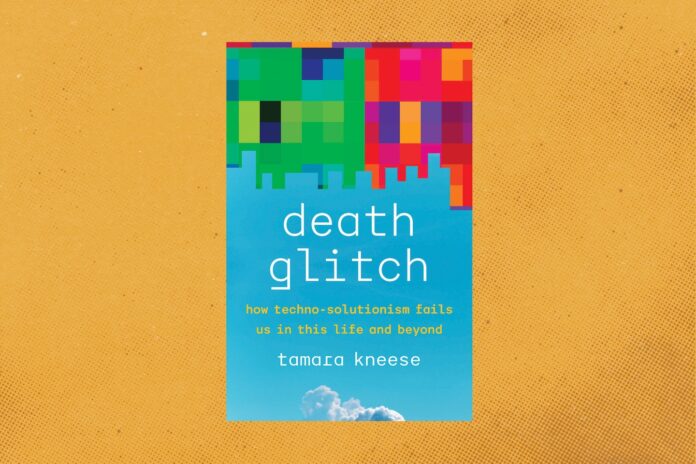The dead make up a surprisingly large portion of the internet’s population — on Facebook alone, dead users are expected to outnumber the living by 2070. But the internet is not designed for them. Hosting services shut down their personal websites at the first missed bill payment. Photo-sharing services stubbornly refuse to let their next of kin access accounts when password recovery becomes impossible. LinkedIn profiles haunt their colleagues by appearing in recommendations of “People you may know.”
Technology scholar Tamara Kneese’s “Death Glitch: How Techno-Solutionism Fails Us in This Life and Beyond” offers a compelling collection of case studies about how technology breaks down when faced with the messiness of mortality. The subject is large, and Kneese tries to make up for the dearth of other writing on it by covering four disparate topic areas: social media memorialization, illness bloggers, digital estate management and transhumanism. Although the stories never cohere into a single narrative, a theme emerges — the cause of these “death glitches” is not the inevitability of decay but the shortsightedness of commercialism. From this perspective, Rustamyan’s defunct epitaph is a result not just of an unlucky guess about which web platform would survive, but also of Yahoo’s cost-cutting measures, first to kill its unprofitable free web hosting service, then to purge its inactive email accounts.
Kneese best captures this clash between capital and internet death in her account of the cottage industry of digital estate management. In the 2000s and 2010s, a wave of start-ups emerged to help customers bequeath passwords, photos, final wishes and other digital remains to those who survived them. With whimsical Silicon Valley names like Dead Man’s Switch and iCroak, these companies combined the 20th-century business model of life insurance with the 21st-century marketing speak of self-care and productivity hacking.
Kneese, like any good ethnographer, signed up for many of these platforms and experienced their glitchiness firsthand. At one point, she received an email with the subject line “Dead Man’s Switch Is Worried About You,” warning that if she didn’t respond within a week, the service would send out all the messages she had scheduled for after her death. Fortunately, Kneese caught the email and had not written any dark secrets or final wishes, as the company suggested she should. If she had, they would have gone to her by-then ex-partner.
Needless to say, nearly all of the digital estate start-ups Kneese tested have since shuttered. As she writes: “Digital estates can last only as long as the commercial platforms and services they depend on. The corporate structure of start-ups favors short life spans and market experimentation, making these companies ill equipped to be transgenerational stewards of anything.”
Kneese constantly highlights the challenges of designing technology that accounts for death, but she rarely gives companies the benefit of the doubt in how they navigate those challenges. For instance, the first chapter recounts the evolution of Facebook’s policy regarding dead users’ profiles. Originally, if Facebook found out that a user had died, it would quietly remove their profile after a 30-day grace period. But the company revisited that policy in 2007, after the Virginia Tech shooting, when victims’ profiles became shrines of collective mourning. Over the next decade and a half, Facebook would introduce a slew of features and design tweaks to better memorialize dead users’ profiles and pass control of them to next of kin.
Here, Kneese dives deep into the knotty problems that death raises for social media. Which information should be kept on a memorialized profile, and which removed for privacy? How can someone prove they should receive a dead user’s profile? How should platforms protect memorialized profiles from being defaced by “RIP trolls”? Facebook seems to earnestly wrestle with these questions, but Kneese characterizes its efforts as a shrewd play for user retention. Memorialization keeps “users invested in an imperfect, aging platform,” she writes. “Through the preservation of profiles, the dead are able to remain productive members of a network.”
The bulk of Kneese’s research tapers off right before the coronavirus pandemic, so she does not delve into the most recent developments on the internet, including the continued ascendancy of recommendation algorithms that drive most of what we see and do online. In this way, “Death Glitch” feels like an artifact of a more idyllic past, a time when one’s digital footprint was a form of self-expression worth preserving, rather than ephemeral feed for an algorithmic trough. In the case of Rustamyan, what feels so dated about the GeoCities link on his nameplate is not just his choice of web hosting service but the fact that he would want his internet presence to be part of his lasting legacy.
The slight outdatedness of “Death Glitch,” though, actually gives it a sharper focus. Today’s fresh AI hell, with chatbots learning to imitate the dead from a handful of text messages and bygone celebrities being resurrected to sell cars, would serve mostly to distract from Kneese’s more timeless point: Death reveals a core power imbalance between technology companies and their users. So much media critical of today’s tech industry is in some sense about that imbalance — Social media is watching you! Hackers have your data! Big companies are too powerful! — but by focusing on death, “Death Glitch” offers a fresh angle to interrogate those relationships anew.
Gabriel Nicholas is a research fellow at the Center for Democracy & Technology and a nonresident fellow at the NYU Information Law Institute.
How Techno-Solutionism Fails Us in This Life and Beyond
A note to our readers
We are a participant in the Amazon Services LLC Associates Program,
an affiliate advertising program designed to provide a means for us to earn fees by linking
to Amazon.com and affiliated sites.



